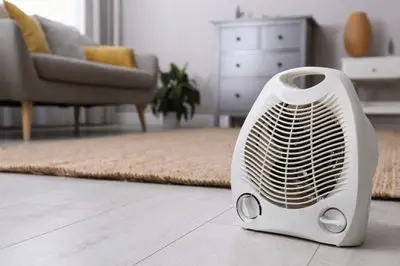We’re letting you know that this post contains sponsored links which Your Savvy Purse receives compensation for, which may impact their order of appearance.
As the temperature drops outside, it’s tempting to crank up the thermostat and let the warmth flood your home. However, constantly increasing the heat can lead to sky-high energy bills and might not be the most energy-efficient way to stay cozy. The good news is there are plenty of ways to make your home feel warmer without touching the thermostat. From simple adjustments to clever tricks, here are some practical tips for creating a snug and inviting atmosphere without over-relying on your heating system.
1. Layer Up with Rugs and Carpets
Bare floors, especially hardwood, tile, or laminate, can feel chilly in the winter. One of the quickest ways to add warmth underfoot is by adding rugs or carpets to your living spaces. Rugs help insulate the floor, reducing the amount of cold air that seeps up from below and making your rooms feel cozier.
- Go for plush rugs: Opt for thicker, more plush rugs that provide extra insulation.
- Use multiple rugs: Layering rugs in high-traffic areas can create an inviting, soft environment while preventing drafts from creeping up.
2. Maximize Natural Light
Letting in as much natural sunlight as possible is one of the simplest ways to warm up a room. The sun’s rays may not provide a drastic temperature change, but they can significantly boost the perceived warmth in your home. Here’s how to make the most of daylight:
- Open your curtains during the day to let in the sun’s warmth.
- Use light-colored, reflective curtains that maximize the sunlight and help brighten up your space.
- Trim back any trees or shrubs that might block the sun’s rays from reaching your windows.
If privacy is a concern, consider sheer curtains that allow light through without sacrificing security.
3. Close Curtains and Blinds at Night
Once the sun sets, it’s time to close your curtains and blinds to help trap the warmth inside. Windows are one of the biggest culprits for heat loss in the winter, so blocking the cold air from entering can make a noticeable difference.
- Use thermal or insulated curtains: These specially designed curtains help keep the cold out and the warmth in, creating an extra barrier between the indoors and outdoors.
- Layer your curtains: If you don’t want to invest in thermal curtains, try layering regular curtains with blackout liners for added insulation.
4. Seal Drafts and Gaps
Cold drafts sneaking in through windows and doors can significantly decrease your home’s warmth. Fortunately, sealing these gaps doesn’t require a major renovation.
- Weatherstrip doors and windows: Adding weatherstripping around doors and windows helps to block drafts and improve overall insulation.
- Use draft stoppers: Place draft stoppers or “door snakes” along the bottoms of doors to prevent warm air from escaping.
- Cover gaps with a plastic film: For windows, consider using clear plastic window insulation film, which can easily be applied with a hairdryer to create an airtight seal.
By cutting down on drafts, you’ll not only feel warmer but also reduce the load on your heating system.
5. Use Space Heaters Strategically
If you’re looking to avoid turning up the central heat, a portable space heater can help. Space heaters are great for targeting specific rooms or areas, so you can stay warm where you need it most without heating the entire house.
- Use ceramic or infrared space heaters: These types of heaters are more energy-efficient and provide fast, direct heat.
- Focus on high-use rooms: If you’re spending a lot of time in one room, such as the living room or bedroom, consider using a space heater to keep that space cozy.
- Remember safety: Always follow the manufacturer’s safety guidelines, keep heaters away from flammable materials, and never leave them running unattended.
6. Embrace the Power of Throw Blankets and Pillows
Adding extra layers to your seating areas is an easy and inexpensive way to create a warm, cozy vibe. Throw blankets and pillows not only look inviting but also provide an extra layer of insulation.
- Layer throws on sofas and chairs: Curling up with a soft, thick throw can make a huge difference in how warm you feel.
- Add decorative cushions: These not only add to the aesthetic appeal of your space but can also contribute to the overall warmth by adding fabric layers to your furniture.
Keep a few throw blankets in strategic spots, such as near your favorite chair or the couch, so they’re easily accessible when you need them.
7. Use a Ceiling Fan in Reverse
It might sound counterintuitive, but ceiling fans can help warm your house in the winter too. Most ceiling fans have a switch that allows the blades to spin in reverse, pushing warm air down from the ceiling and redistributing it throughout the room. This is particularly helpful in rooms with high ceilings where warm air tends to rise.
- Set your fan to spin clockwise at a low speed. This will help circulate warm air without creating a chilly breeze.
- Use ceiling fans in rooms with high ceilings to evenly distribute heat, making the room feel warmer without the need for additional heating.
8. Cook and Bake
If you enjoy cooking, the winter months provide the perfect excuse to make hearty meals that will not only warm your body but also heat up your home. Whether it’s baking bread, making soup, or simmering a stew, using the oven or stove top can add both physical and psychological warmth to your space.
- Bake or roast: Roasting vegetables, baking cookies, or preparing casseroles can add a cozy atmosphere to your kitchen and the surrounding areas.
- Keep the oven door open: After baking, leave the oven door open (with caution) to let the residual heat warm up your kitchen.
- Cook with a slow cooker or Instant Pot: These appliances also add warmth while cooking your favorite meals.
9. Add Layers of Lighting
Lighting plays a big role in setting the mood of a room, and during the colder months, warm lighting can help create a cozy ambiance. Swap out harsh, cool-toned light bulbs for soft, warm-toned bulbs to make your space feel more inviting.
- Use table lamps and floor lamps: Rather than relying on overhead lights, use soft lamps to add warmth and a gentle glow to your space.
- Add candles: Scented or unscented candles not only provide light but can also create a cozy atmosphere. Consider lighting a few candles in your living room or bedroom for a peaceful, warm feel.
10. Dress for Warmth
Sometimes, making your home feel warmer is simply about adjusting your own habits. When you’re cozy in your clothes, you’re less likely to feel the chill.
- Layer up: Wear warm clothing like sweaters, fleece socks, and thick pajamas.
- Consider heated blankets or pads: Electric blankets or heating pads are great for snuggling up without needing to turn up the heat.
Final Thoughts
Creating a warmer, more comfortable home doesn’t have to mean cranking up the heat and watching your energy bills soar. By combining a few of these clever tricks—like layering rugs, sealing drafts, maximizing sunlight, and using space heaters—you can enjoy a cozy atmosphere while keeping things efficient and budget-friendly. So, the next time you feel the chill, try some of these easy tips to make your home feel like a warm, inviting retreat without the need to touch the thermostat.
Stay warm, inside and out!



